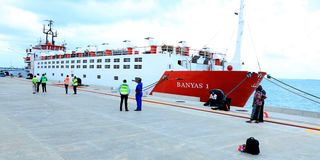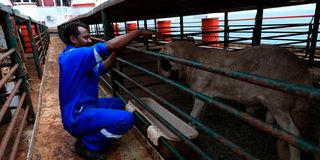Lamu port readies for second livestock export to Oman in a month

Mv Banyas 1 Lome Vessel which docked at the Port of Lamu Berth Number 1 in this photo taken on October 15, 2022.
The second shipment of livestock to Oman through the Lamu port will take place this week.
The MV Banyas 1 docked at the port last Saturday and is expected to carry 7,000 animals, said Lamu port Cargo Operations Manager Peter Masinde.
The vessel transported about 16,000 animals to Oman three weeks ago.
“We have not received the exact figures of the animals to be exported to Oman in this second shipment yet, though for planning purposes, we were given a figure of 300 live bulls, 1,000 camels, and 6,000 goats and sheep,” Mr Masinde said.
“Discussions, consolidation and reconciliation of figures is on and the number is subject to change.”
He urged livestock keepers in Lamu and Northern Kenya counties to take advantage of the export programme by investing in quality production of livestock and bringing the animals for sale.
“This programme is a relief to livestock keepers in Lamu and the Northern Kenya counties. They now have a ready overseas market for their camels, cows, goats, and sheep. There is also an assured demand, hence assured revenue from their livestock sales,” he said.

An employee cleans a sheep inside MV Banyas 1 Lome Vessel at the Port of Lamu on October 15, 2022. The vessel will transport livestock for export to Oman.
Lapsset Regional Manager Salim Bunu told Nation.Africa that the livestock export programme was turning around the fortunes of pastoralist communities in Lamu and Northern Kenya.
“Now that we have a port in Lamu and a road to Garissa, Isiolo and Moyale, we urge livestock keepers to take advantage of the Lamu port and the ready market for livestock sold to Oman,” said Mr Bunu.
The Lapsset corridor is a regional flagship project intended to provide transport and logistics infrastructure and create seamless connectivity between the eastern African countries of Kenya, Ethiopia and South Sudan.
The project connects about 160 million people in the three countries.
Lapsset is also part of the larger transport route that will connect the East African coast from the Lamu port to the West African coast of Africa in Douala in Cameroon.
Livestock keepers lauded the live exports to the Gulf via the Lamu port, saying it will save them from losses that they incur during droughts.
“This has given us an opportunity to sell animals in large numbers to Oman and evade the losses that might have occurred when our animals die due to lack of water and pasture, particularly the current ravaging drought,” said Abdulrahman Guyo.




